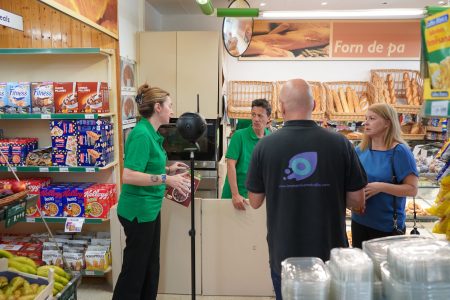We used to think that the best way to present a case study was through a document of about 3 to 10 pages or a PowerPoint presentation of about 20 to 40 slides. But another way to do it is with Virtual Reality (VR) with which we can bring study cases into life. Interactive 360-degree videos are a very powerful tool to provide people with immersive and experiential learning. Watching and listening to an explanation can be useful in some cases, but being able to find yourself in the middle of the action in a more experiential way can bring out much more intense feelings and sensations. The emotions we feel when experiencing an action are much more powerful than those we experience if we only see it on a screen.
For example, in this article published by United Nations System Staff College (UNSSC), they realized that using 360-degree videos and VR tools are the best way to present a case study about sustainable development. They brought several UN leaders to visit a couple of cities in a country whose economic development had been largely dependent on mining lignite coal for centuries. They also provided them with training from subject matter experts to increase their knowledge around sustainable development topics, especially on complex concepts such as the interconnectedness of sustainable development goals, transboundary and intergenerational issues. When their participants told them they wished they could let their teams, counterparts in the government, and partners experience the site visit, then they realized that they could convert document-based case studies and site- visits into Virtual Reality tours.
A story of transformational change for sustainable development

A Story of Transformational Change for Sustainable Development is an interactive Virtual Reality training on ecological transition and sustainable development designed to train political and technical United Nations member countries leaders. This training has been co-created by Immersium Studio and United Nations System Staff College.
This case study begins with a dilemma that involved the government requiring to close its coal mines by 2030. This meant the city needed to rethink and reimagine their future without mining and keeping the coal underground. The experience consists of a visit to a city that has undergone an ecological transition in recent years. It is a city traditionally dependent on extractive coal mining activity, with all the social, political and economic implications that this entails. Public institutions have made great efforts to reformulate the city’s economic model and transform it into a city with a green, circular economy that respects sustainalibity three dimensions (economic, environmental and social).
You can read more information about this project here.
In this video you could see a brief resume about this immersive experience.
This Virtual Reality learning experience was presented in COP 27 in Sharm El-Sheikh in Egypt by UNSSC. The climate change conference brings together 45,000 people worldwide to take action on climate change. They show the VR Tour at the Resilience Frontiers Pavillion at COP 27. Participants noted how they felt that they were in the city and that the affected people were in front of them. More importantly, those who participated in the VR experience were brimming with insights, questions, and ideas in a safe learning space that was provided for this purpose.

This experience with Virtual Reality and 360-degree videos taught us that there is huge potential to use VR and 360-degree videos to present case studies on sustainable development concepts and climate action, since it allows learners to reimagine a desired future with a more equitable, peaceful, and sustainable world. However, a solid and good storyboarding process is extremely crucial when using 360-degree videos and VR.
Paulyn Duman from UNSSC explained in their Blog that integrating knowledge, skills and attitudes in complex learning topics such as sustainability can be more easily achieved by using new digital technologies as Virtual Reality. She also presented our VR experience in Online Educa Berlín 2022.
“Learners can experience real-life case studies through site visits or immerse themselves in hypothetical situations through Virtual Reality or interactive 360-degree videos. In these environments, the learners reflect upon varying knowledge, attitudes, and skills in different situations to make decisions and judgments.”
We are very happy that Virtual Reality can be useful in environmental fields such as showing the sustainability of a city or some experience to become aware of climate change. Immersive experiences are a very powerful tool to be able to show in first person the specific characteristics of a place or visualize a future that can come true. We are sure that experiences like this one that we have developed for the United Nations will become more and more common to make the population aware that climate change is real, but we can face it little by little and with perseverance.




